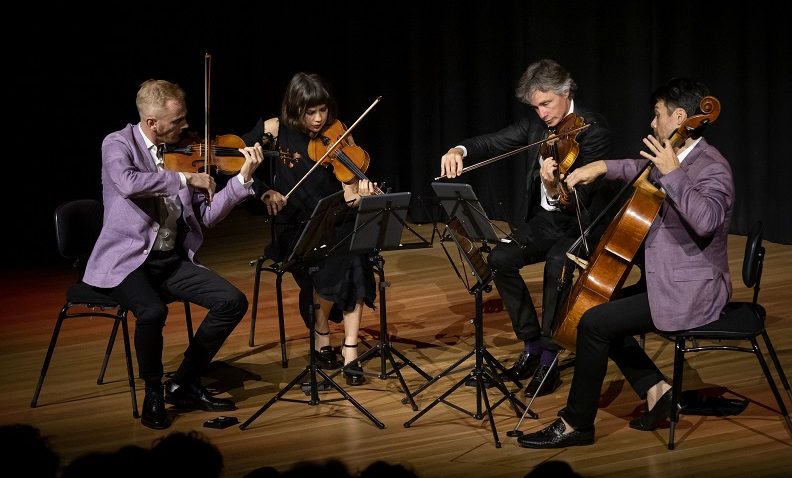
Australian String Quartet, James O Fairfax Theatre, National Gallery of Australia, June 3. Reviewed by CLINTON WHITE.
THE affectionate farewell for Canberra-raised violist, Stephen King, in his last concert appearance in Canberra with the Australian String Quartet, made an already warm, intimate ambience in the James O Fairfax Theatre even friendlier.
King is not leaving the ASQ though. He will be its director of learning and engagement, so it’s almost certain his hometown will still see him from time to time, just not on stage.
And this concert, whose program was as diverse as it was fascinating and enjoyable, added even further to the festive atmosphere. King and his colleagues, violinists Dale Barltrop and Francesca Hiew, and cellist Michael Dahlenburg (on his first ASQ tour), played with such precision and empathy, they drew an enthusiastic standing ovation at the end.
First up was Hungarian composer, Béla Bartók’s third string quartet, written in 1927. Even though it has four parts, they are played “attacca”, that is, without breaks in between.
Dahlenburg called it “beautifully bleak”.
The ensemble expertly handled the complex harmonies and dissonances, its unusual bowing techniques, its at once subdued and then frenetic paces, and its abstract melodies.
Then it was Mendelssohn’s first string quartet, written when he was 20, almost a century earlier than Bartók’s piece. He had been to England and Scotland and written the “Scottish” symphony and the “Hebrides” overture. Although by then the Romantic era was well underway, this work is less of the lushness of that period and more in the classical style.

Here the ensemble settled in to the many facets of the work, again with aplomb. It begins softly and slowly but picks up the pace in the approach to the second movement, which is the really fun and most charming part, before hints of melancholy and perhaps even sadness and anger in the third and the dance-like mood of the final movement, which paradoxically, finishes quietly.
Finally, it was back to the 20th century and a work by the Moravian composer, Pavel Fischer. His third string quartet, nicknamed “Mad Piper”, was inspired by the bravery of the Scottish piper, Bill Millin, who played the bagpipes during the D-Day landing at Normandy in World War II. The German troops did not fire at him because they thought he had gone mad. It was they who named him the Mad Piper.
Barltrop described the work as energetic and rambunctious.
The work is full of energetic and stylised eastern European folk tunes and dances. But perhaps there’s some American influence in there as well, for hints of a hoedown are more than obvious in the first movement. A long, rather gorgeous viola solo, which is given subtle accompaniment on the other instruments, seemed to fit the occasion of King’s farewell perfectly. The piece concludes fast and furious, with string slapping and plucking, and frenzied fiddling, with the violist at one point even slapping the shoulder of his instrument. It was fun from beginning to end.
The Australian String Quartet gave Fischer’s piece a lively, energetic performance, and got rousing applause, complete with whistling and whooping, in response.
What a fine outfit the ASQ is!
Who can be trusted?
In a world of spin and confusion, there’s never been a more important time to support independent journalism in Canberra.
If you trust our work online and want to enforce the power of independent voices, I invite you to make a small contribution.
Every dollar of support is invested back into our journalism to help keep citynews.com.au strong and free.
Thank you,
Ian Meikle, editor








Leave a Reply